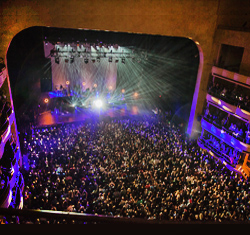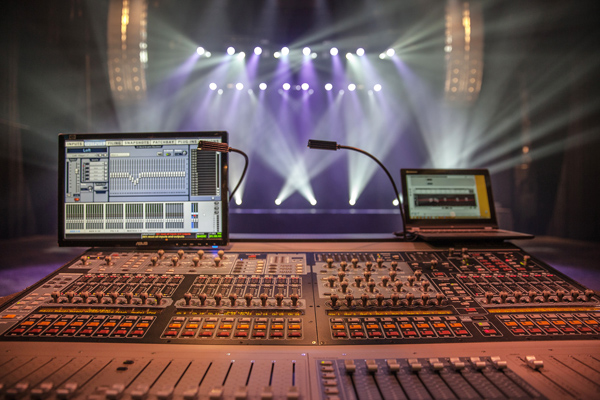
“Additionally, since the mains extend down to 35 Hz, we’re getting the majority of the musical content from them and low and high frequencies are similar in output across the venue,” he continues. “It also sounds more musical because the source, say the kick drum’s attack and impact, is coming from one place.”
A dozen L-Acoustics SB28 dual-18-inch subwoofers on the ground provide what Sullivan characterizes as “infrasonic” support: “Moving air, but not necessarily providing a whole lot of musical content, as we’re able to get most of that out of the K2.”
The subs are usually on end, six per side, tightly packed, but can be re-arranged depending on the room configuration, with a cardioid mode available to reduce the amount of back-firing energy concerts.
Up to six L-Acoustics KARA line source loudspeakers can be deployed for front fill. “Sometimes four of these function as front fills and two sit on top of the subs, so you can do the DJ version of ‘Texas headphones’ if you want,” Auslan notes. And, the stage is now served by up to 16 L-Acoustics 115XT HiQ active monitors and HiQ subs.
Five LA-RAK modular touring racks, each containing three LA8 amplified controllers, drive all main system loudspeakers and subwoofers. The mobile touring version of the racks, as opposed to the install version, were chosen for portability in meeting the needs of the different configurations.
Completing The Process
Both house and monitor systems are now headed by Avid VENUE Profile digital consoles, selected because they provide plenty of capability in addition to being rider-friendly. System integrator See Factor, involved with the project from the outset, also provided all equipment and implemented a custom fabricated snake and split system.
“It’s an analog split because it needs to be with these consoles, and there’s a copper fan-out for the stage rack and then coax running out to the house console,” explains Mark Friedman of See Factor. Also on hand now are four Shure UR4D+ dual-channel wireless microphone systems and what Friedman terms an “industry standard” complement of Shure and Sennheiser wired microphones.
The project was completed in September of this year, with the new audio infrastructure making the venue eminently more functional for all manner of applications. “There are two main things to take into consideration in any installation,” Friedman concludes. “One of them is providing the most appropriate equipment to suit the venue and the room. The second – particularly for a venue that has multiple uses and applications – is providing something that’s as close to ‘all things to all people’ as possible.
“Obviously, you need the best fit from a technical standpoint, and then the most universally accepted products out there. In this case the K2 was truly the best fit for the room, regardless of market acceptance, and I dare say there’s probably not going to be one band ever that comes through there that’s not going to accept it.”
Based in Toronto, Kevin Young is a freelance music and tech writer, professional musician and composer.

